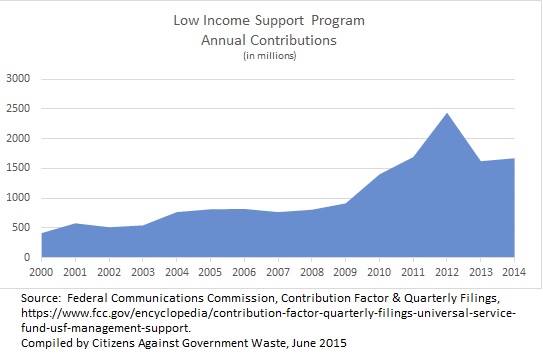Tossing a Broken Lifeline to Subsidize Broadband
In 2014, approximately $8.5 billion was collected in Universal Service Fund (USF) fees from consumers as a tax on their communications services. The four main USF programs are the Low-Income support services, which includes the Lifeline and Link-Up programs; the High-Cost program; the E-Rate Library and Schools program; and the Rural Health program. While there are many questions and concerns about all of these programs, the Lifeline program, which was established in 1985 to provide subsidized telephone services to low-income households, has perhaps the most sordid history of waste, fraud and abuse.
In 2008, the Lifeline program was expanded to allow telephone companies to provide discounted wireless service, including prepaid wireless phones in some states, to certain eligible individuals. In October 2010, the Government Accountability Office (GAO) published a report that revealed an increase in demand for the Lifeline program between 2008 and 2009 from 7.1 million households to 8.6 million households, attributable in part to the increased availability of discounted wireless service. Subscriptions through the program more than doubled from 8.6 million in 2009 to 18 million in 2012.
The GAO report revealed multiple instances of Lifeline program fraud and abuse. For example, some recipients were using Craigslist to advertise the sale of Lifeline-subsidized phones and service. In other cases, Lifeline beneficiaries violated the one phone line restriction of the program by signing up for service from multiple carriers. On June 29, 2011, the FCC published the Lifeline Reform Order (Reform Order) to address the fraud and eligibility issues highlighted in the GAO report.
The Reform Order included changes to the Lifeline program such as reinforcing the one-per-household rule; developing uniform eligibility standards; de-enrolling subscribers who do not use the service for 60 consecutive days; making payments based on actual support claims; conducting independent and first-year audits; developing a National Lifeline Accountability Database; using a flat-rate reimbursement; verifying an applicant’s eligibility at enrollment and annually through recertification; developing a broadband pilot program; and defining performance measures to evaluate progress toward ensuring the availability of voice service and broadband for low-income Americans, as well as the minimization of the USF contribution burden on consumers and businesses.

A positive result of the Reform Order’s requirement to more strictly adhere to eligibility requirements was a reduction of 33 percent in the number of household using the Lifeline program between 2012 and 2014, from 18 million to 12 million, and overall spending on the Low-Income program dropped from $2.4 billion in 2012 to $1.6 billion in 2014. However, GAO’s March 24, 2015 follow-up report, found that several reforms had not been effective and the FCC needs to do more to address deficiencies in the program. In addition, GAO found that households continue to face challenges in accessing and keeping Lifeline benefits because of additional paperwork required to confirm eligibility for the program.
In addition, GAO found that the FCC lacked an evaluation plan for the data it gathered through its broadband pilot program. Only one-tenth of the expected 74,000 customers enrolled in the 14 pilot broadband projects before the program ended in October 2014. Despite these abysmal results, the FCC is now discussing plans to expand the program by adding broadband services as another option for eligible subscribers. It is unknown how the FCC would implement these changes to the Lifeline program, because the proposal will not be available for public review until after the full commission votes on it during its June 18, 2015 meeting. However, there is no doubt that expanding eligible services to include broadband will increase the cost of the program once again.
The Senate Subcommittee on Communications, Technology, Innovation, and the Internet held a hearing on June 2, 2015 to review the progress being made by the FCC in its reforms of the Lifeline program. During the hearing, Free State Foundation President Randy May stated, “The results from the FCC’s broadband pilot program demonstrate the challenges inherent in attempting to expand the program to include broadband without, at the same time, increasing substantially the total amount of subsidies provided.”
The FCC should proceed with great caution when considering the expansion of broadband services to the Lifeline program. As demonstrated by the dramatic increase in demand that began in 2008 when wireless services were added to the options for low-income subscribers to its peak year in 2012 before reform measures were implemented, adding broadband to the Lifeline program will increase financial demands on the USF program and consumers of communications services, and likely be fraught with waste, fraud, abuse, and mismanagement.
